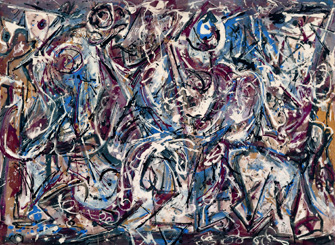|
|
|
Nicolas de Staël’s “Mediterranean Landscape” (1953). Madrid, Thyssen-Bornemisza Museum. © Adagp, Paris 2010 |
The idea that the work of Impressionist painter Claude Monet prefigured 20th-century abstract painting is not new, but “Monet et l’Abstraction,” the current temporary exhibition at the …
 |
|
Nicolas de Staël’s “Mediterranean Landscape” (1953). Madrid, Thyssen-Bornemisza Museum. © Adagp, Paris 2010 |
The idea that the work of Impressionist painter Claude Monet prefigured 20th-century abstract painting is not new, but “Monet et l’Abstraction,” the current temporary exhibition at the Musée Marmottan Monet, illustrates it beautifully.
This small show offers up some 20 masterworks by Monet from the museum’s own strong collection and hangs them beside works by later abstract painters. It starts off strongly with Monet’s “Impression, Sunrise” (1873), the work that gave Impressionism its name, hanging next to Mark Rothko’s “Untitled” (1969). The reddish-orange tones of the two-tone Rothko painting echo the red-orange sun and its reflections in the water and sky in the Monet. They are followed by a large painting by Adolph Gottlieb, “Roman Three” (1962), with a green orb circled by intense yellow against a muted yellow background and three dabs of color – rust, dark green and bright yellow – in the lower right-hand corner. This wonderful trio showing artists at play with color leads to another experiment in color by Hans Hofmann: on a messy splash of crimson that covers most of the canvas, the artist has placed two precise vertical bands of color, one Yves Klein blue and the other almost fluorescent green, to blinding effect.
An interesting contrast is provided by the juxtaposition of Monet’s “Haystack” (1889-90) with “Image with Three Spots” (1914) by Wassily Kandinsky, considered the first truly abstract painter. The Monet exudes a feeling of otherworldly tranquility, with the haystack glowing in the evening light, while Kandinsky’s vivid colors dance wildly and brilliantly on the canvas, yet there is a definite kinship between the two works, with a similar palette handled in a completely different ways. (In fact, Kandinsky had seen some of Monet’s haystack paintings in Moscow in 1895 and was struck not only by the colors but also by the fact that these works “discredited” the necessity of the object in a painting, as he later wrote.)
Monet’s densely painted later paintings, in which his garden at Giverny nearly dissolves in deep color, show a strong affinity with the work of
 |
|
Jackson Pollock: “Untitled” (1946). Thyssen-Bornemisza Collection, Madrid. © Adagp, Paris 2010 |
Jackson Pollock, represented here by three paintings, including the lovely shimmering, subtly colored “Number 11, 1950.” Both artists seem to apply the paint freely while paradoxically controlling it tightly.
While Nicolas de Stael was not technically an abstract painter, his works, like Monet’s, approached abstraction, and – also like Monet – he was a colorist extraordinaire. His vibrant “Mediterranean Landscape” (1953; pictured at the top of the page) hangs next to Monet’s “Branch of the Seine near Giverny, Sunrise” (1897), each one a sumptuous symphony in blue.
Gerhard Richter’s “Abstract Painting, Lake” (1997) hangs next to a Monet water lily painting dating from 1916-19 and looks like a condensed, extreme abstraction of it.
The list of artists on show also includes Clyfford Still, Mark Tobey, Zao Wou-Ki, Maria Helena Vieira da Silva, Joan Mitchell, Sam Francis and more. A discovery for me was Esteban Vicente, whose luscious “Solitude” (1991), in greens, orange and red, hangs next to Monet’s “Hemerocallis” (1914-17).
This little gem of a show is a perfect summer activity and offers visitors to this lovely museum in a mansion on the edge of Paris a new way of looking its extensive collection of Monet paintings. Refreshingly, the exhibition includes hardly any wall texts, just a few short blurbs that provide a little guidance, allowing visitors to draw their own conclusions.
Musée Marmottan Monet: 2, rue Louis-Boilly, 75016, Paris. Métro: Muette. Tel.: 01 42 24 07 02. Open Tuesday, 11am-9pm, Wednesday-Saturday, 11am-6pm. Closed Monday. Admission: €9. Through September 26. www.marmottan.com
Order books on Monet from Paris Update’s Amazon store at no extra cost. Click on your preferred Amazon location: U.K., France, U.S.
Support Paris Update by ordering books from Paris Update’s Amazon store at no extra cost. Click on your preferred Amazon location: U.K., France, U.S.
Reader Reaction: Click here to respond to this article (your response may be published on this page and is subject to editing).
More reviews of Paris art shows.
© 2010 Paris Update
Favorite